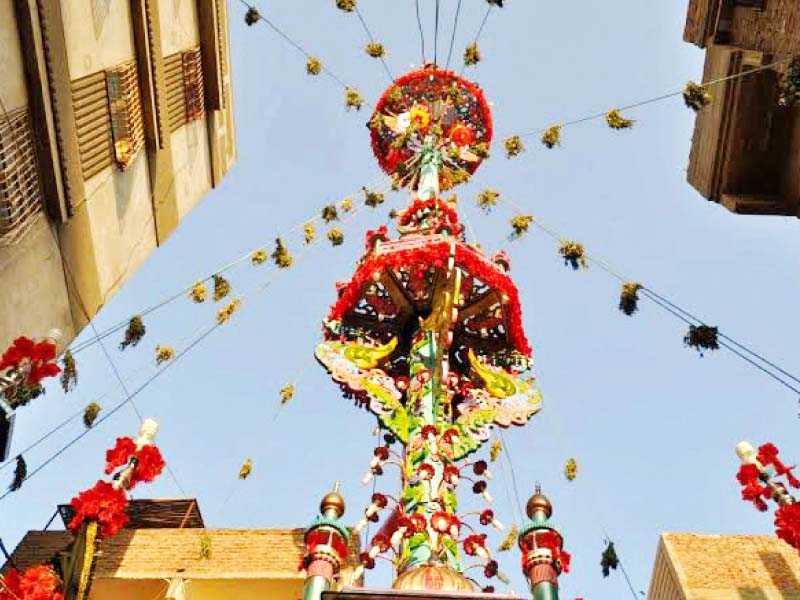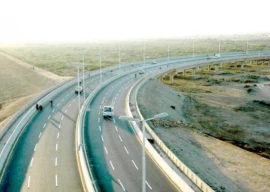
These round poles were mounted with oil lanterns on top but just beneath the flag. The bigger ones among these wooden artefacts elevated up to around a 100 feet or more. With the passage of time decorations, such as two-dimensional wooden peacocks or pigeons, sparrows, parrots and shapes of leaves as well as small replicas of the venerated shrines, all painted in vivid colours, were also added.
The sentiments of Karbala do not only belong to Shias
The ornate work of art so produced is a remembrance of the alam [the flag] which Hazrat Ghazi Abbas (RA), a son of Hazrat Ali (RA), carried in Karbala. Every year, before the advent of Muharram, the dedicated groups of carpenters create new alams while renovating the older ones.
Among the hundreds of alams in Hyderabad, the tallest ones are installed at Jamaitian Jo Pirh (96 feet), Wadhan Jo Pirh (92 feet) and Qadam Gah (90 feet). There are six alams that go up to 80 feet while there are over 50 alams that vary in height between 80 feet and 50 feet. Most people also prefer to place smaller ones of the roof or the balconies of their homes.
 Wadhan Jo Pirh is one of the tallest alams in Hyderabad, going up to 92 feet in height. It is also the most expensive alam decorated with real gold. PHOTO: ADEEL AHMED / EXPRESS
Wadhan Jo Pirh is one of the tallest alams in Hyderabad, going up to 92 feet in height. It is also the most expensive alam decorated with real gold. PHOTO: ADEEL AHMED / EXPRESSInfluence of the Talpurs
This trend, which is part of Hyderabad's heritage now, flourished during the reign of the Talpur dynasty (1783-1843) during the late 18th century and thrives till this day.
Tight security: Yaum-e-Ali (RA) procession takes place peacefully
"Talpur era is synonymous with the Azadari [mourning the martyrdom of Hazrat Imam Hussain (RA) and his companions in Karbala]," said Zawar Abdul Sattar Dars, who has dozens of books and booklets on the history and evolution of Azadari to his credit. "They took Azadari to new heights by establishing imambargahs, promoting alams, tazias [small replicas of the shrine of Hazrat Imam Hussain (RA)], pirh [mourning processions or a site where an alam is located] and majalis."
 Qasain (Butchers) Jo Pirh was built earlier in the 20th century. PHOTO: ADEEL AHMED / EXPRESS
Qasain (Butchers) Jo Pirh was built earlier in the 20th century. PHOTO: ADEEL AHMED / EXPRESSThe dynasty's first ruler, Mir Fateh Ali Khan Talpur, built an imambargah inside Pakka Qila soon after establishing himself in the fort after defeating the Kalhoro rulers of Sindh. A few years later, Mir Muhammad Nasser Khan Talpur, one of his sons, founded another imambargah near present-day Home Stead Hall and it was where the first big alam was put up.
Faqir Muhammad Junejo, the general of Mir Fateh's army, placed another alam in the area in downtown Hyderabad, which is still named Faqir Jo Pirh after him. "The majority of people who inhabited the city then were Moulai [Sunnis who observed Muharram by organising mourning events but were not followers of the Shia sect] and they contributed equally to the promotion of this culture," Dars pointed out.
I felt safer in Iraq than I do in Pakistan
Within a decade from 1800 AD, at least 24 new sites with alams appeared in the city, in addition to four others that predate the Talpurs by a century or more, and most of them still exist. Khair Shah Jo Pirh and Dargah Ashraf Shah aka Charlie Ellicot Jo Pirh are two of the ones that existed before the Talpurs, while Data Juman Shah, Dargah Gul Shah, Dargah Ali Asghar Shah, Qadam Gah Maula Ali (RA) and Dinal Shah are among those that were built by the Talpurs.
 Qadam Gah Maula is 90 feet in height. PHOTO: ADEEL AHMED / EXPRESS
Qadam Gah Maula is 90 feet in height. PHOTO: ADEEL AHMED / EXPRESS"The alam at Qadam Gah was put up in the early 19th century soon after the Talpur's brought musallah [prayer mat of stone with imprints of Hazrat Ali's (RA) forehead, hands, knees and feet in position of prostration] from Iran in 1805," said Mirza Aashiq Baig, former mayor of Hyderabad district council and the incumbent caretaker of Qadam Gah.
Alam making
"Making alam is like an obligation of our faith. We don't do it only for business," asserted the elderly carpenter, Ali Dino Vighio, who learned this art from his ancestors, who settled in Hyderabad's Wadhan Jo Pirh area during the Talpur era.
Security heightened for Muharram processions
He explained that the alam's pole, called naizo in Sindhi, is preferably made from teak and oak trees, with their height going up to 130 feet. For a bigger alam that goes up to 70 feet or higher, two pieces of 30 to 40 feet can also be joined to make the naizo.
 Khair Shah Jo Pirh was built even before the Talpurs came to rule in Hyderabad. PHOTO: ADEEL AHMED / EXPRESS
Khair Shah Jo Pirh was built even before the Talpurs came to rule in Hyderabad. PHOTO: ADEEL AHMED / EXPRESSThe large ones are built on a five- to seven-foot foundation made of concrete and tied with ropes to the ground or a building. The essential components include small and large designs of birds, mainly peacocks, and leaves referred to as madan, one or more round plates, domes and a piece of cloth for flag called bairak. A range of other decorative items are also added to increase the beauty. The oil lanterns stand replaced with the luminous electric fittings.
The construction of a large alam can cost at least Rs500,000. "But it can increase ten-fold if someone chooses to use the best kind of the wood, colours and gold in place of the metal works," pointed out Vighio.
The bigger alams with extensive woodcarving on naizo and madan take between four to five months to build while the ordinary ones can be prepared in a month.
Published in The Express Tribune, October 23rd, 2015.

















COMMENTS
Comments are moderated and generally will be posted if they are on-topic and not abusive.
For more information, please see our Comments FAQ